2016 NISSAN ROGUE seats
[x] Cancel search: seatsPage 376 of 478
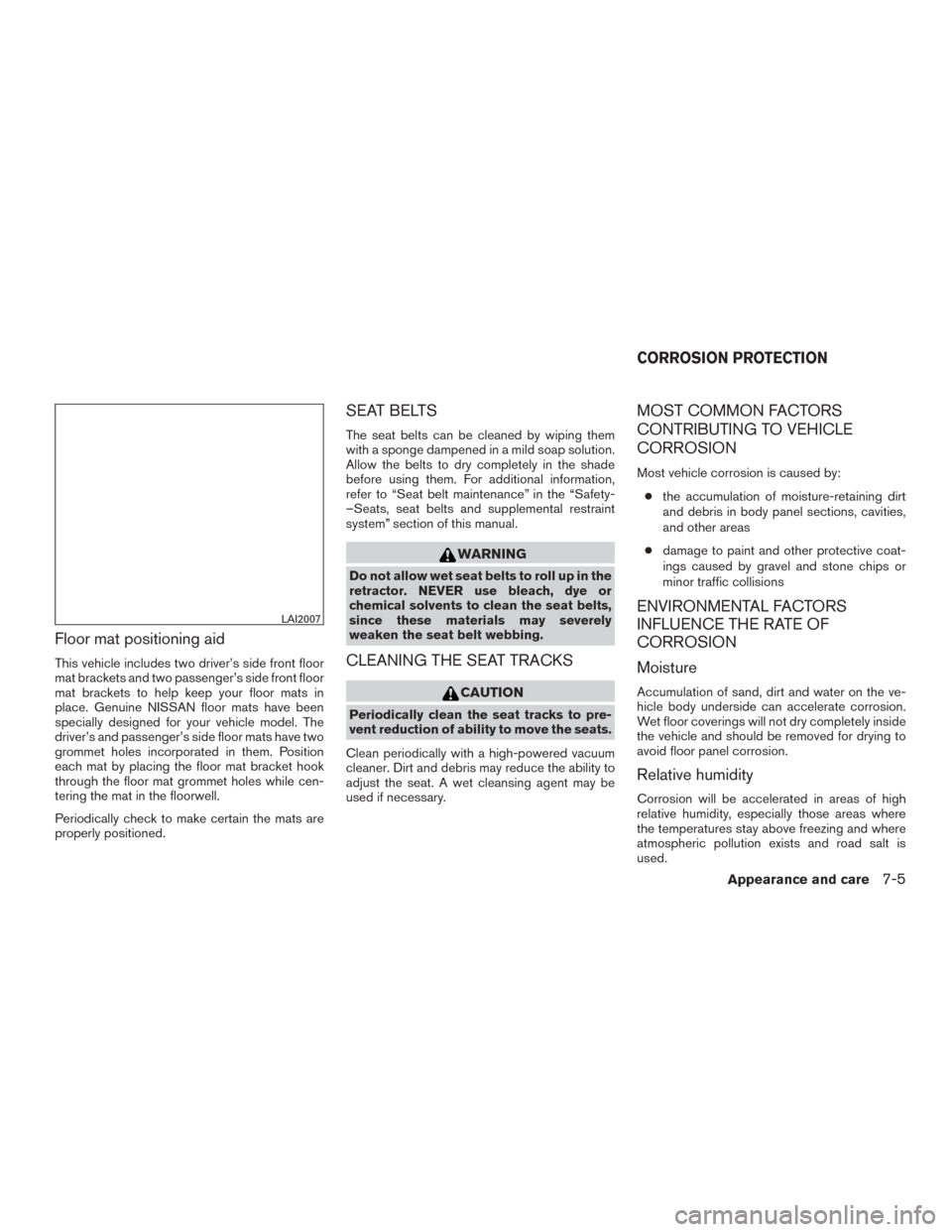
Floor mat positioning aid
This vehicle includes two driver’s side front floor
mat brackets and two passenger’s side front floor
mat brackets to help keep your floor mats in
place. Genuine NISSAN floor mats have been
specially designed for your vehicle model. The
driver’s and passenger’s side floor mats have two
grommet holes incorporated in them. Position
each mat by placing the floor mat bracket hook
through the floor mat grommet holes while cen-
tering the mat in the floorwell.
Periodically check to make certain the mats are
properly positioned.
SEAT BELTS
The seat belts can be cleaned by wiping them
with a sponge dampened in a mild soap solution.
Allow the belts to dry completely in the shade
before using them. For additional information,
refer to “Seat belt maintenance” in the “Safety-
–Seats, seat belts and supplemental restraint
system” section of this manual.
WARNING
Do not allow wet seat belts to roll up in the
retractor. NEVER use bleach, dye or
chemical solvents to clean the seat belts,
since these materials may severely
weaken the seat belt webbing.
CLEANING THE SEAT TRACKS
CAUTION
Periodically clean the seat tracks to pre-
vent reduction of ability to move the seats.
Clean periodically with a high-powered vacuum
cleaner. Dirt and debris may reduce the ability to
adjust the seat. A wet cleansing agent may be
used if necessary.
MOST COMMON FACTORS
CONTRIBUTING TO VEHICLE
CORROSION
Most vehicle corrosion is caused by: ● the accumulation of moisture-retaining dirt
and debris in body panel sections, cavities,
and other areas
● damage to paint and other protective coat-
ings caused by gravel and stone chips or
minor traffic collisions
ENVIRONMENTAL FACTORS
INFLUENCE THE RATE OF
CORROSION
Moisture
Accumulation of sand, dirt and water on the ve-
hicle body underside can accelerate corrosion.
Wet floor coverings will not dry completely inside
the vehicle and should be removed for drying to
avoid floor panel corrosion.
Relative humidity
Corrosion will be accelerated in areas of high
relative humidity, especially those areas where
the temperatures stay above freezing and where
atmospheric pollution exists and road salt is
used.
LAI2007
CORROSION PROTECTION
Appearance and care7-5
Page 380 of 478
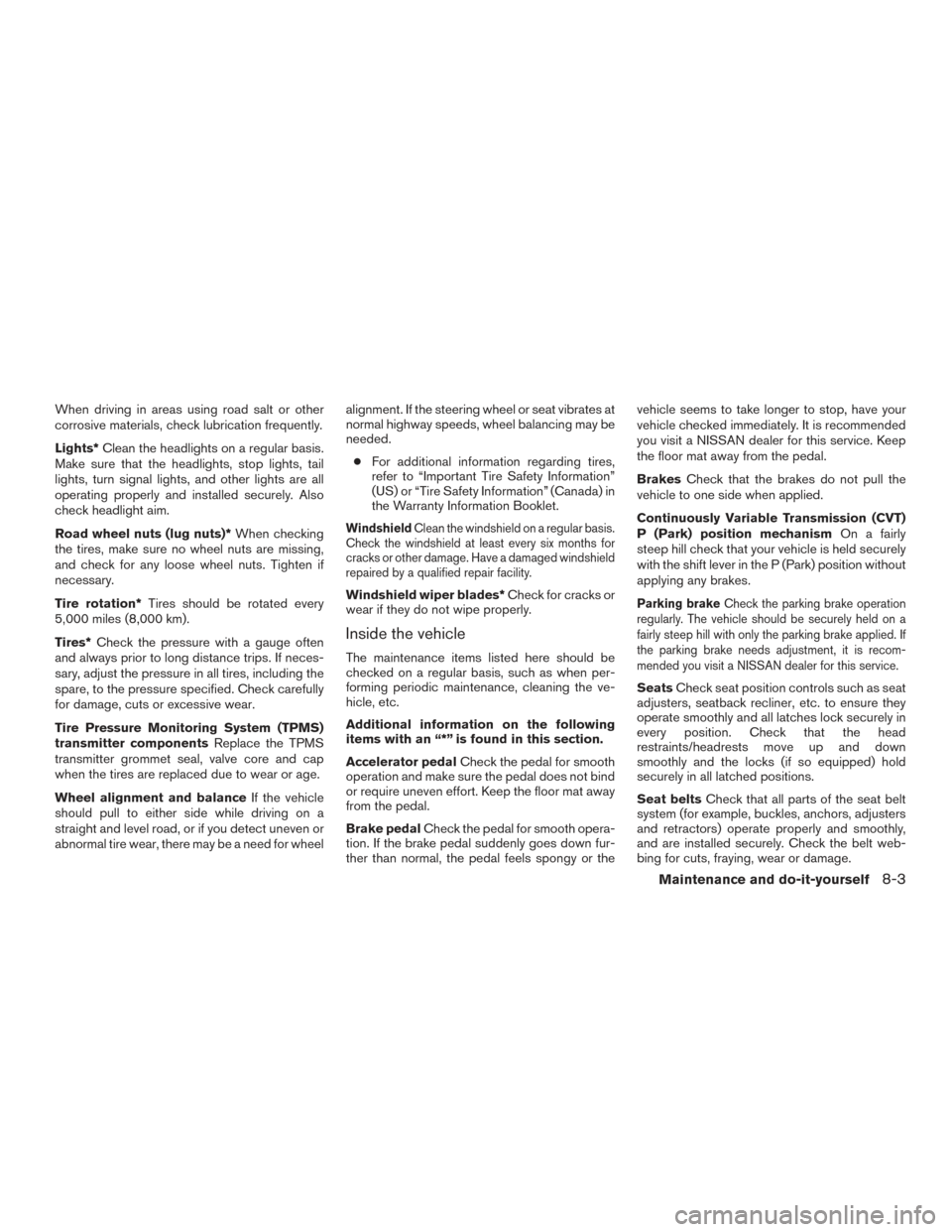
When driving in areas using road salt or other
corrosive materials, check lubrication frequently.
Lights*Clean the headlights on a regular basis.
Make sure that the headlights, stop lights, tail
lights, turn signal lights, and other lights are all
operating properly and installed securely. Also
check headlight aim.
Road wheel nuts (lug nuts)* When checking
the tires, make sure no wheel nuts are missing,
and check for any loose wheel nuts. Tighten if
necessary.
Tire rotation* Tires should be rotated every
5,000 miles (8,000 km).
Tires* Check the pressure with a gauge often
and always prior to long distance trips. If neces-
sary, adjust the pressure in all tires, including the
spare, to the pressure specified. Check carefully
for damage, cuts or excessive wear.
Tire Pressure Monitoring System (TPMS)
transmitter components Replace the TPMS
transmitter grommet seal, valve core and cap
when the tires are replaced due to wear or age.
Wheel alignment and balance If the vehicle
should pull to either side while driving on a
straight and level road, or if you detect uneven or
abnormal tire wear, there may be a need for wheel alignment. If the steering wheel or seat vibrates at
normal highway speeds, wheel balancing may be
needed.
● For additional information regarding tires,
refer to “Important Tire Safety Information”
(US) or “Tire Safety Information” (Canada) in
the Warranty Information Booklet.
Windshield Clean the windshield on a regular basis.
Check the windshield at least every six months for
cracks or other damage. Have a damaged windshield
repaired by a qualified repair facility.
Windshield wiper blades* Check for cracks or
wear if they do not wipe properly.
Inside the vehicle
The maintenance items listed here should be
checked on a regular basis, such as when per-
forming periodic maintenance, cleaning the ve-
hicle, etc.
Additional information on the following
items with an “*” is found in this section.
Accelerator pedal Check the pedal for smooth
operation and make sure the pedal does not bind
or require uneven effort. Keep the floor mat away
from the pedal.
Brake pedal Check the pedal for smooth opera-
tion. If the brake pedal suddenly goes down fur-
ther than normal, the pedal feels spongy or the vehicle seems to take longer to stop, have your
vehicle checked immediately. It is recommended
you visit a NISSAN dealer for this service. Keep
the floor mat away from the pedal.
Brakes
Check that the brakes do not pull the
vehicle to one side when applied.
Continuously Variable Transmission (CVT)
P (Park) position mechanism On a fairly
steep hill check that your vehicle is held securely
with the shift lever in the P (Park) position without
applying any brakes.
Parking brake Check the parking brake operation
regularly. The vehicle should be securely held on a
fairly steep hill with only the parking brake applied. If
the parking brake needs adjustment, it is recom-
mended you visit a NISSAN dealer for this service.
Seats Check seat position controls such as seat
adjusters, seatback recliner, etc. to ensure they
operate smoothly and all latches lock securely in
every position. Check that the head
restraints/headrests move up and down
smoothly and the locks (if so equipped) hold
securely in all latched positions.
Seat belts Check that all parts of the seat belt
system (for example, buckles, anchors, adjusters
and retractors) operate properly and smoothly,
and are installed securely. Check the belt web-
bing for cuts, fraying, wear or damage.
Maintenance and do-it-yourself8-3
Page 436 of 478
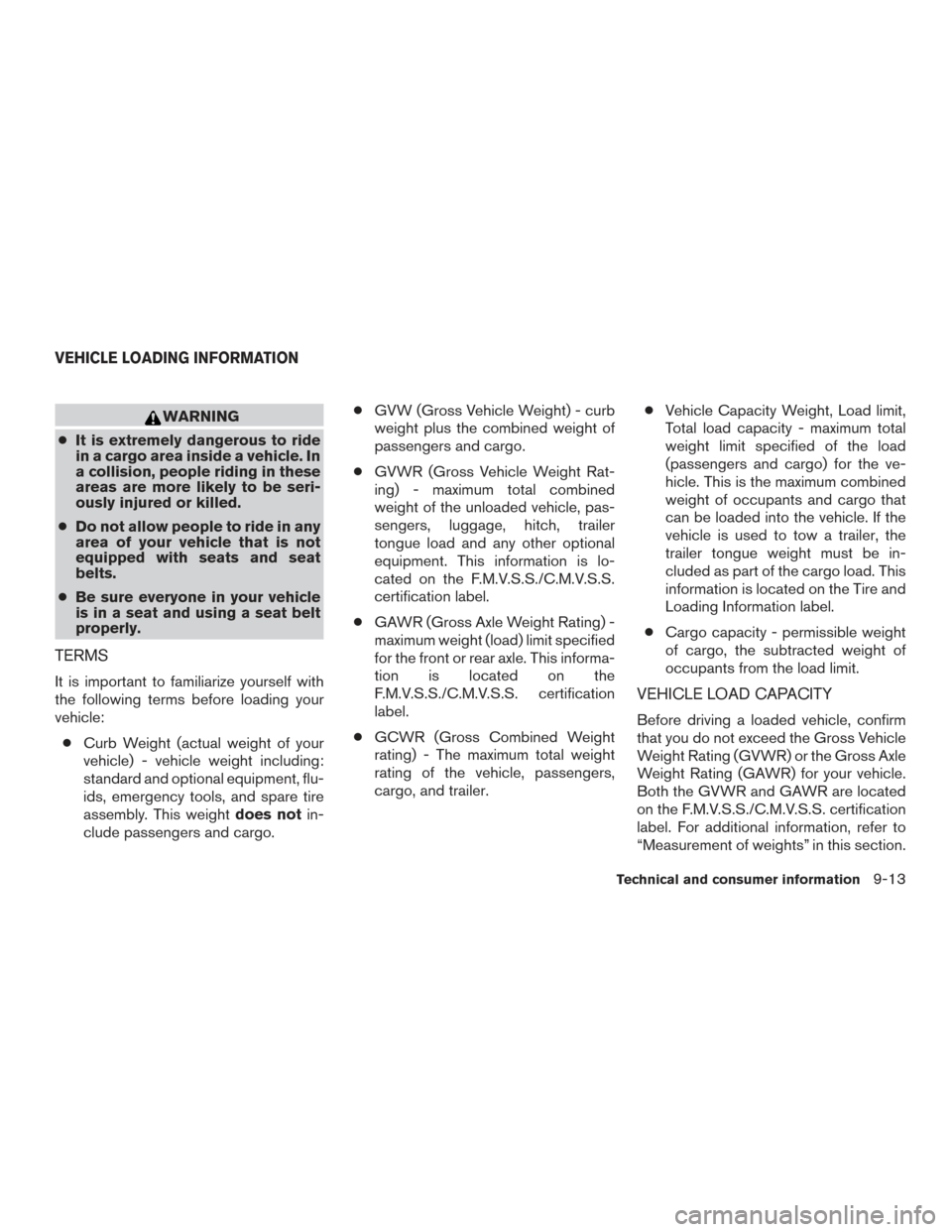
WARNING
● It is extremely dangerous to ride
in a cargo area inside a vehicle. In
a collision, people riding in these
areas are more likely to be seri-
ously injured or killed.
● Do not allow people to ride in any
area of your vehicle that is not
equipped with seats and seat
belts.
● Be sure everyone in your vehicle
is in a seat and using a seat belt
properly.
TERMS
It is important to familiarize yourself with
the following terms before loading your
vehicle:
● Curb Weight (actual weight of your
vehicle) - vehicle weight including:
standard and optional equipment, flu-
ids, emergency tools, and spare tire
assembly. This weight does notin-
clude passengers and cargo. ●
GVW (Gross Vehicle Weight) - curb
weight plus the combined weight of
passengers and cargo.
● GVWR (Gross Vehicle Weight Rat-
ing) - maximum total combined
weight of the unloaded vehicle, pas-
sengers, luggage, hitch, trailer
tongue load and any other optional
equipment. This information is lo-
cated on the F.M.V.S.S./C.M.V.S.S.
certification label.
● GAWR (Gross Axle Weight Rating) -
maximum weight (load) limit specified
for the front or rear axle. This informa-
tion is located on the
F.M.V.S.S./C.M.V.S.S. certification
label.
● GCWR (Gross Combined Weight
rating) - The maximum total weight
rating of the vehicle, passengers,
cargo, and trailer. ●
Vehicle Capacity Weight, Load limit,
Total load capacity - maximum total
weight limit specified of the load
(passengers and cargo) for the ve-
hicle. This is the maximum combined
weight of occupants and cargo that
can be loaded into the vehicle. If the
vehicle is used to tow a trailer, the
trailer tongue weight must be in-
cluded as part of the cargo load. This
information is located on the Tire and
Loading Information label.
● Cargo capacity - permissible weight
of cargo, the subtracted weight of
occupants from the load limit.VEHICLE LOAD CAPACITY
Before driving a loaded vehicle, confirm
that you do not exceed the Gross Vehicle
Weight Rating (GVWR) or the Gross Axle
Weight Rating (GAWR) for your vehicle.
Both the GVWR and GAWR are located
on the F.M.V.S.S./C.M.V.S.S. certification
label. For additional information, refer to
“Measurement of weights” in this section.
VEHICLE LOADING INFORMATION
Technical and consumer information9-13
Page 454 of 478
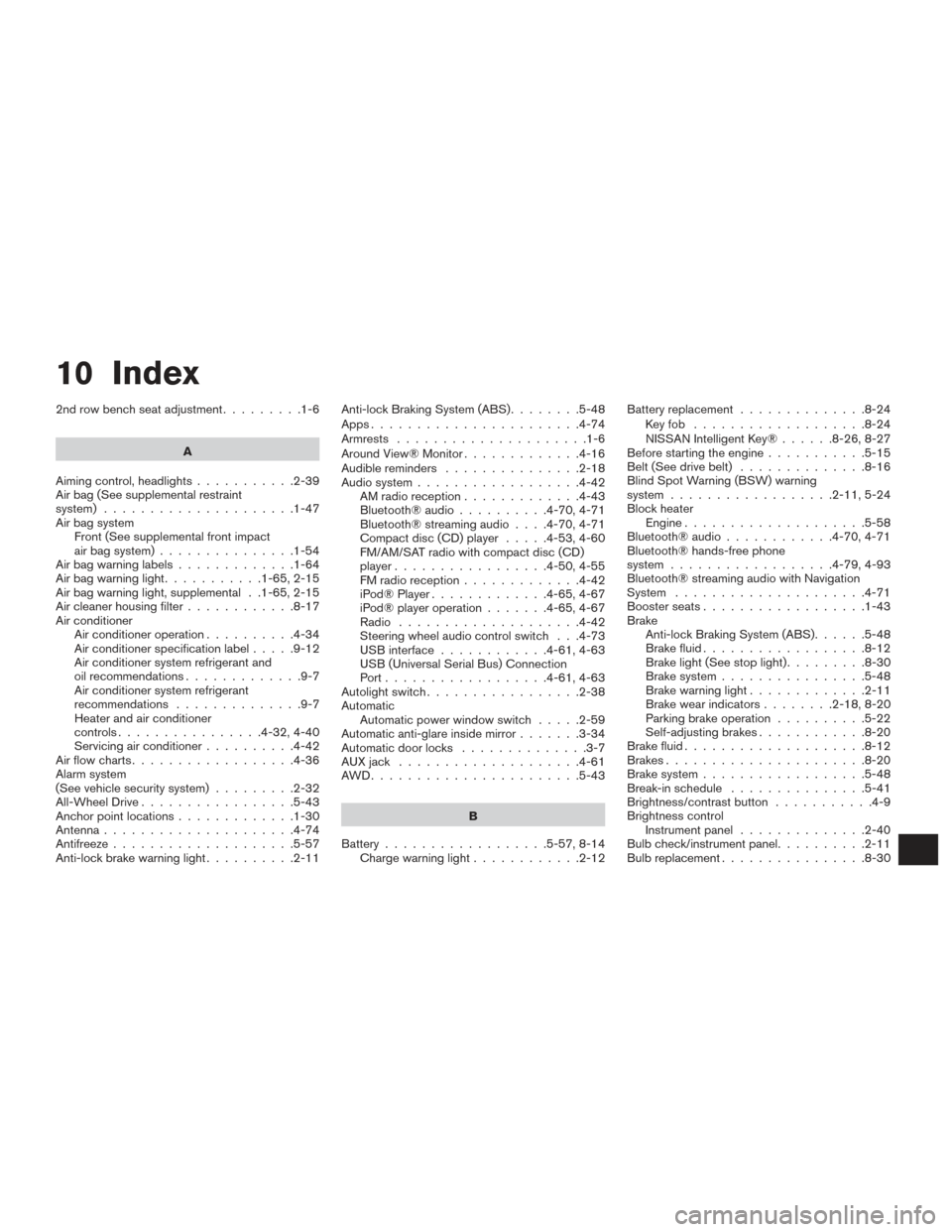
10 Index
2nd row bench seat adjustment.........1-6
A
Aiming control, headlights ...........2-39
Air bag (See supplemental restraint
system) .....................1-47
Air bag system Front (See supplemental front impact
air bag system) ...............1-54
Airbagwarninglabels.............1-64
Airbagwarninglight...........1-65,2-15
Air bag warning light, supplemental . .1-65, 2-15
Air cleaner housing filter ............8-17
Air conditioner Air conditioner operation ..........4-34
Air conditioner specification label .....9-12
Air conditioner system refrigerant and
oil recommendations .............9-7
Air conditioner system refrigerant
recommendations ..............9-7
Heater and air conditioner
controls................4-32,4-40
Servicing air conditioner ..........4-42
Airflowcharts..................4-36
Alarm system
(See vehicle security system) .........2-32
All-Wheel Drive .................5-43
Anchor point locations .............1-30
Antenna .....................4-74
Antifreeze ....................5-57
Anti-lock brake warning light ..........2-11Anti-lock Braking System (ABS)
........5-48
Apps .......................4-74
Armrests .....................1-6
AroundView®Monitor.............4-16
Audible reminders ...............2-18
Audio system ..................4-42
AMradioreception.............4-43
Bluetooth®audio..........4-70,4-71
Bluetooth® streaming audio ....4-70,4-71
Compact disc (CD) player .....4-53,4-60
FM/AM/SAT radio with compact disc (CD)
player.................4-50,4-55
FMradioreception.............4-42
iPod® Player .............4-65,4-67
iPod® player operation .......4-65,4-67
Radio ....................4-42
Steering wheel audio control switch . . .4-73
USB interface ............4-61,4-63
USB (Universal Serial Bus) Connection
Port..................4-61,4-63
Autolight switch .................2-38
Automatic Automatic power window switch .....2-59
Automatic anti-glare inside mirror .......3-34
Automatic door locks ..............3-7
AUXjack ....................4-61
AWD.......................5-43
B
Battery ..................5-57,8-14
Chargewarninglight............2-12 Battery replacement
..............8-24
Keyfob ...................8-24
NISSAN Intelligent Key® ......8-26,8-27
Before starting the engine ...........5-15
Belt (See drive belt) ..............8-16
Blind Spot Warning (BSW) warning
system..................2-11,5-24
Block heater Engine ....................5-58
Bluetooth® audio ............4-70,4-71
Bluetooth® hands-free phone
system..................4-79,4-93
Bluetooth® streaming audio with Navigation
System .....................4-71
Boosterseats..................1-43
Brake Anti-lock Braking System (ABS) ......5-48
Brake fluid ..................8-12
Brakelight(Seestoplight).........8-30
Brake system ................5-48
Brakewarninglight.............2-11
Brakewearindicators........2-18,8-20
Parking brake operation ..........5-22
Self-adjusting brakes ............8-20
Brake fluid ....................8-12
Brakes ......................8-20
Brake system ..................5-48
Break-inschedule ...............5-41
Brightness/contrast button ...........4-9
Brightness control Instrument panel ..............
2-40
Bulb check/instrument panel ..........2-11
Bulbreplacement................8-30
Page 456 of 478
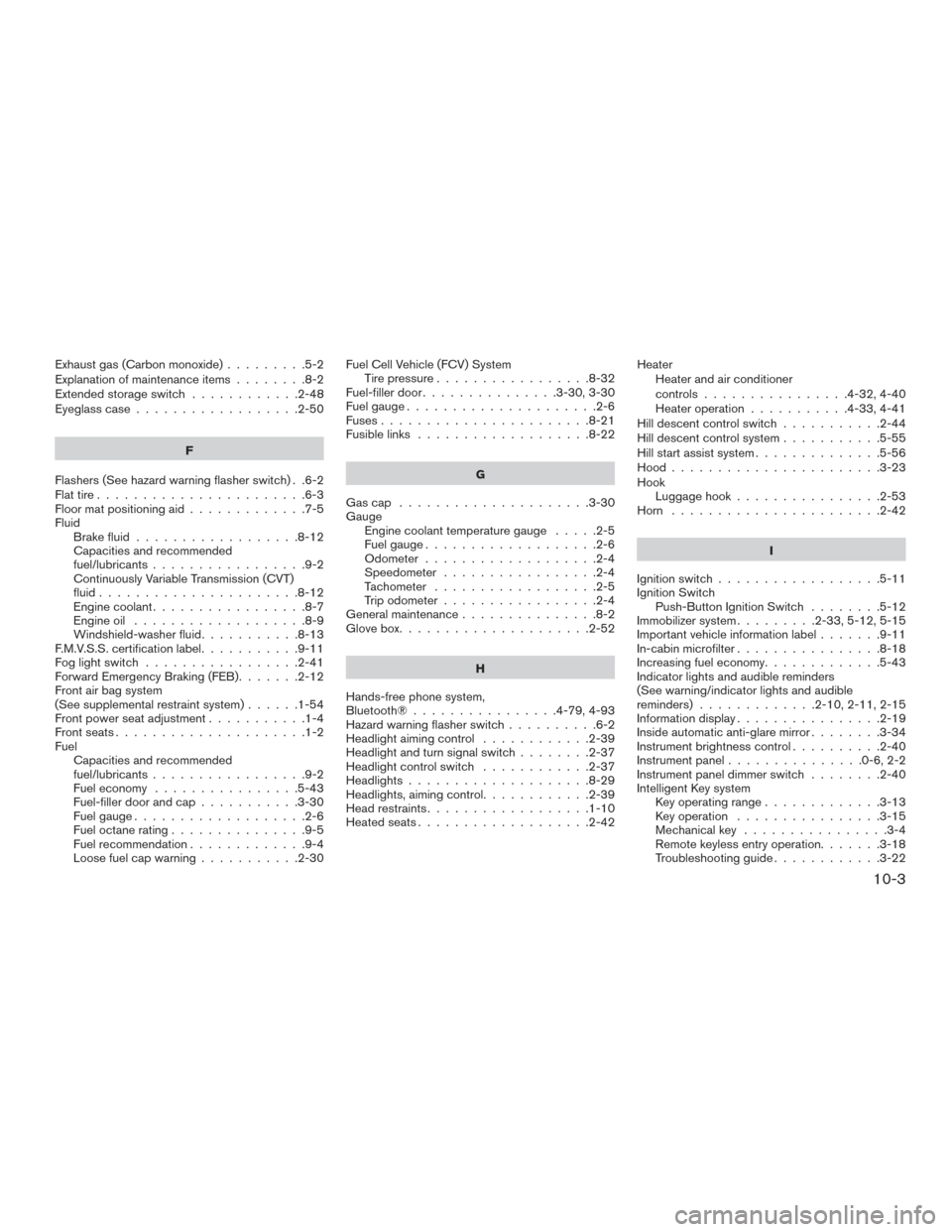
Exhaust gas (Carbon monoxide).........5-2
Explanation of maintenance items ........8-2
Extendedstorageswitch ............2-48
Eyeglass case ..................2-50
F
Flashers (See hazard warning flasher switch) . .6-2
Flat tire .......................6-3
Floor mat positioning aid .............7-5
Fluid Brake fluid ..................8-12
Capacities and recommended
fuel/lubricants .................9-2
Continuously Variable Transmission (CVT)
fluid......................8-12
Engine coolant .................8-7
Engine oil ...................8-9
Windshield-washerfluid...........8-13
F.M.V.S.S. certification label ...........9-11
Foglightswitch .................2-41
Forward Emergency Braking (FEB) .......2-12
Front air bag system
(See supplemental restraint system) ......1-54
Front power seat adjustment ...........1-4
Frontseats.....................1-2
Fuel Capacities and recommended
fuel/lubricants .................9-2
Fuel economy ................5-43
Fuel-filler door and cap ...........3-30
Fuel gauge ...................2-6
Fuel octane rating ...............9-5
Fuel recommendation .............9-4
Loose fuel cap warning ...........2-30 Fuel Cell Vehicle (FCV) System
Tirepressure.................8-32
Fuel-filler door ...............3-30,3-30
Fuelgauge.....................2-6
Fuses.......................8-21
Fusiblelinks ...................8-22
G
Gascap .....................3-30
Gauge Engine coolant temperature gauge .....2-5
Fuel gauge ...................2-6
Odometer ...................2-4
Speedometer .................2-4
Tachometer ..................2-5
Trip odometer .................2-4
General maintenance ...............8-2
Glovebox.....................2-52
H
Hands-free phone system,
Bluetooth®................4-79,4-93
Hazard warning flasher switch ..........6-2
Headlight aiming control ............2-39
Headlight and turn signal switch ........2-37
Headlight control switch ............2-37
Headlights ....................8-29
Headlights, aiming control ............2-39
Head restraints ..................1-10
Heated seats ...................2-42 Heater
Heater and air conditioner
controls ................4-32,4-40
Heater operation ...........4-33,4-41
Hill descent control switch ...........2-44
Hill descent control system ...........5-55
Hill start assist system ..............5-56
Hood.......................3-23
Hook Luggage hook ................2-53
Horn .......................2-42
I
Ignition
switch ..................5-11
Ignition Switch Push-Button Ignition Switch ........5-12
Immobilizer system .........2-33,5-12,5-15
Important vehicle information label .......9-11
In-cabin microfilter ................8-18
Increasing fuel economy .............5-43
Indicator lights and audible reminders
(See warning/indicator lights and audible
reminders).............2-10,2-11,2-15
Information display ................2-19
Inside automatic anti-glare mirror ........3-34
Instrument brightness control ..........2-40
Instrumentpanel...............0-6,2-2
Instrument panel dimmer switch ........2-40
Intelligent Key system Key operating range .............3-13
Key operation ................3-15
Mechanical key ................3-4
Remote keyless entry operation.......3-18
Troubleshooting guide ............3-22
10-3
Page 458 of 478
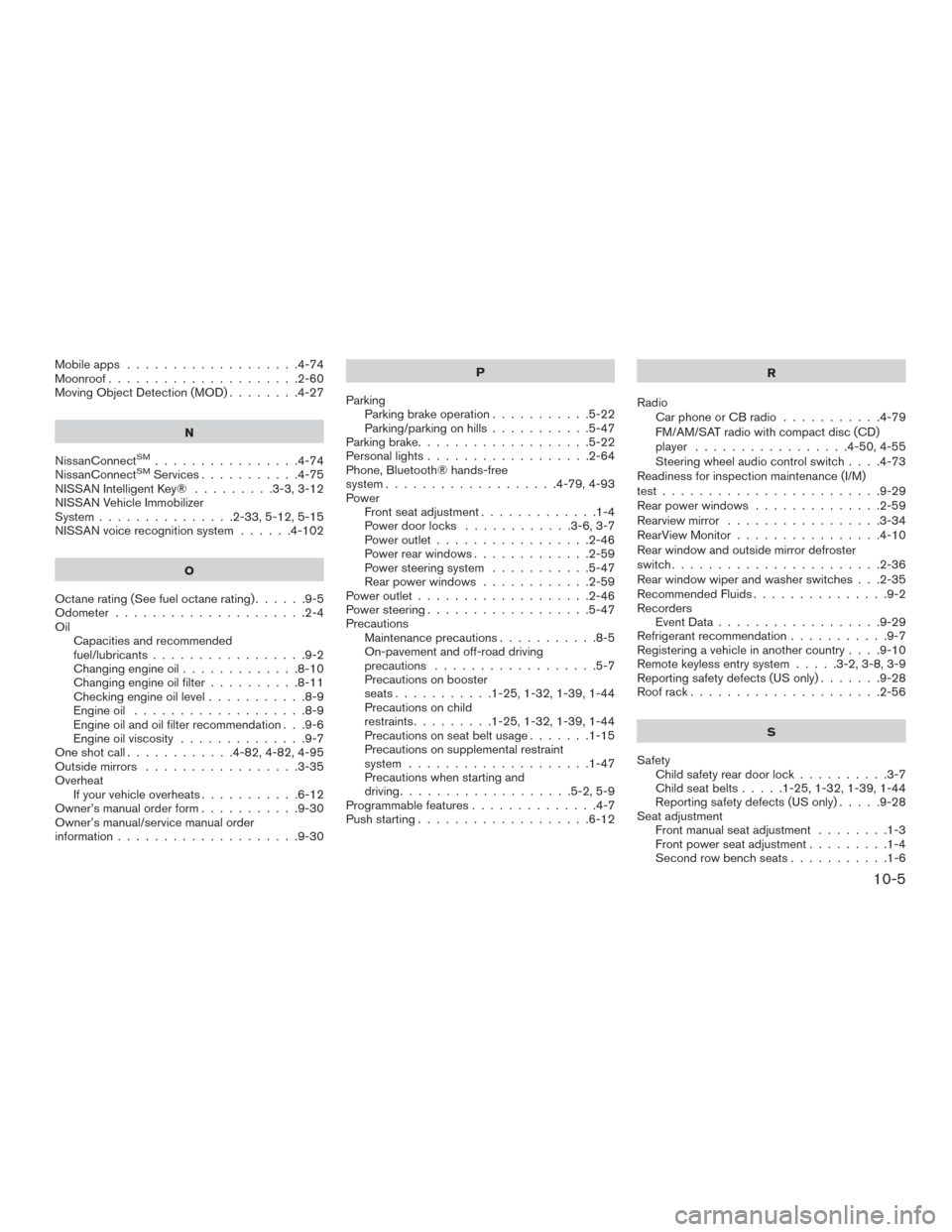
Mobileapps ...................4-74
Moonroof.....................2-60
Moving Object Detection (MOD) ........4-27
N
NissanConnect
SM................4-74
NissanConnectSMServices...........4-75
NISSAN Intelligent Key® .........3-3,3-12
NISSAN Vehicle Immobilizer
System ...............2-33,5-12,5-15
NISSAN voice recognition system ......4-102
O
Octanerating(Seefueloctanerating)......9-5
Odometer .....................2-4
Oil Capacities and recommended
fuel/lubricants .................9-2
Changing engine oil .............8-10
Changing engine oil filter ..........8-11
Checking engine oil level ...........8-9
Engine oil ...................8-9
Engine oil and oil filter recommendation . . .9-6
Engine oil viscosity ..............9-7
Oneshotcall............4-82,4-82,4-95
Outside mirrors .................3-35
Overheat Ifyourvehicleoverheats...........6-12
Owner’s manual order form ...........9-30
Owner’s manual/service manual order
information ....................9-30 P
Parking Parking brake operation ...........5-22
Parking/parking on hills ...........5-47
Parking brake ...................5-22
Personallights..................2-64
Phone, Bluetooth® hands-free
system ...................4-79,4-93
Power Front seat adjustment .............1-4
Power door locks ............3-6,3-7
Power outlet .................2-46
Power rear windows .............2-59
Power steering system ...........5-47
Rear power windows ............2-59
Power outlet ...................2-46
Power steering ..................5-47
Precautions Maintenance precautions ...........8-5
On-pavement and off-road driving
precautions ..................5-7
Precautions on booster
seats...........1-25,1-32,1-39,1-44
Precautions on child
restraints .........1-25,1-32,1-39,1-44
Precautions on seat belt usage .......1-15
Precautions on supplemental restraint
system ....................1-47
Precautions when starting and
driving ...................5-2,5-9
Programmablefeatures..............4-7
Push starting ...................6-12 R
Radio CarphoneorCBradio ...........4-79
FM/AM/SAT radio with compact disc (CD)
player .................4-50,4-55
Steering wheel audio control switch . . . .4-73
Readiness for inspection maintenance (I/M)
test ........................9-29
Rear power windows ..............2-59
Rearview mirror .................3-34
RearView Monitor ................4-10
Rear window and outside mirror defroster
switch.......................2-36
Rear window wiper and washer switches . . .2-35
Recommended Fluids ...............9-2
Recorders EventData..................9-29
Refrigerant recommendation ...........9-7
Registering a vehicle in another country ....9-10
Remote keyless entry system .....3-2,3-8,3-9
Reporting
safety defects (US only) .......9-28
Roof rack .....................2-56
S
Safety Child safety rear door lock ..........3-7
Child seat belts .....1-25,1-32,1-39,1-44
Reporting safety defects (US only) .....9-28
Seat adjustment Front manual seat adjustment ........1-3
Front power seat adjustment .........1-4
Secondrowbenchseats...........1-6
10-5
Page 459 of 478
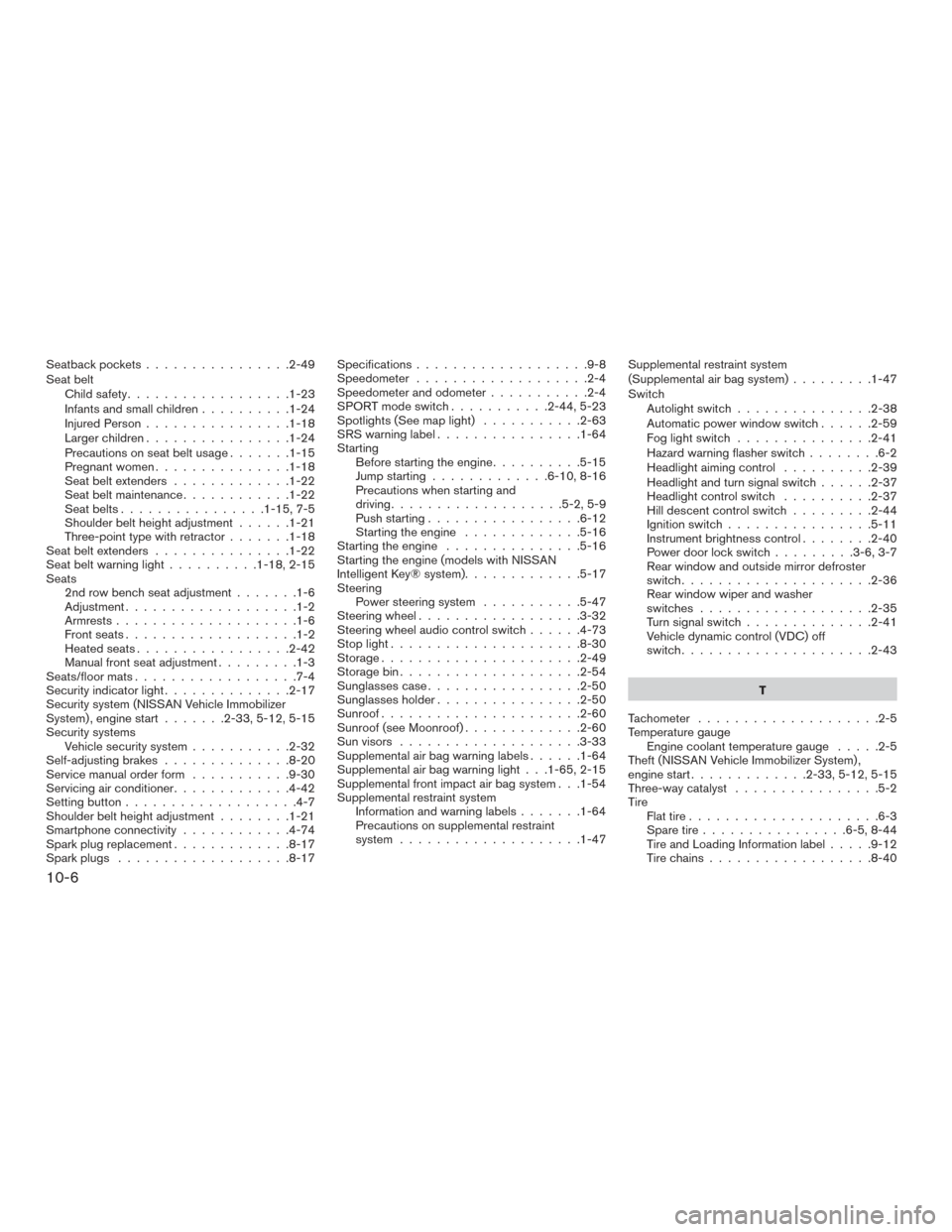
Seatback pockets................2-49
Seat belt Childsafety..................1-23
Infantsandsmallchildren..........1-24
Injured Person ................1-18
Largerchildren................1-24
Precautionsonseatbeltusage.......1-15
Pregnant women ...............1-18
Seat belt extenders .............1-22
Seat belt maintenance ............1-22
Seat belts ................1-15,7-5
Shoulder belt height adjustment ......1-21
Three-point type with retractor .......1-18
Seat belt extenders ...............1-22
Seatbeltwarninglight..........1-18,2-15
Seats 2nd row bench seat adjustment .......1-6
Adjustment ...................1-2
Armrests....................1-6
Frontseats...................1-2
Heatedseats.................2-42
Manual front seat adjustment .........1-3
Seats/floor mats ..................7-4
Security indicator light ..............2-17
Security system (NISSAN Vehicle Immobilizer
System) , engine start .......2-33,5-12,5-15
Security systems Vehicle security system ...........2-32
Self-adjusting brakes ..............8-20
Service manual order form ...........9-30
Servicing air conditioner .............4-42
Setting button ...................4-7
Shoulder belt height adjustment ........1-21
Smartphone connectivity ............4-74
Spark plug replacement .............8-17
Spark plugs ...................8-17 Specifications
...................9-8
Speedometer ...................2-4
Speedometer and odometer ...........2-4
SPORT mode switch ...........2-44,5-23
Spotlights(Seemaplight) ...........2-63
SRSwarninglabel................1-64
Starting Before starting the engine ..........5-15
Jump starting .............6-10,8-16
Precautions when starting and
driving ...................5-2,5-9
Push starting .................6-12
Starting the engine .............5-16
Starting the engine ...............5-16
Starting the engine (models with NISSAN
Intelligent Key® system) .............5-17
Steering Power steering system ...........5-47
Steeringwheel..................3-32
Steering wheel audio control switch ......4-73
Stoplight.....................8-30
Storage......................2-49
Storagebin....................2-54
Sunglassescase.................2-50
Sunglassesholder................2-50
Sunroof......................2-60
Sunroof(seeMoonroof).............2-60
Sun visors ....................3-33
Supplemental air bag warning labels ......1-64
Supplemental air bag warning light . . .1-65, 2-15
Supplemental front impact air bag system . . .1-54
Supplemental restraint system Information and warning labels .......1-64
Precautions on supplemental restraint
system ....................1-47 Supplemental restraint system
(Supplemental air bag system)
.........1-47
Switch Autolightswitch...............2-38
Automatic power window switch ......2-59
Fog light switch ...............2-41
Hazard warning flasher switch ........6-2
Headlightaimingcontrol ..........2-39
Headlightandturnsignalswitch......2-37
Headlight control switch ..........2-37
H
illdescentcontrolswitch.........2-44
Ignition switch ................5-11
Instrument brightness control ........2-40
Power door lock switch .........3-6,3-7
Rear window and outside mirror defroster
switch .....................2-36
Rear window wiper and washer
switches ...................2-35
Turnsignalswitch..............2-41
Vehicle dynamic control (VDC) off
switch .....................2-43
T
Tachometer ....................2-5
Temperature gauge Engine coolant temperature gauge .....2-5
Theft (NISSAN Vehicle Immobilizer System) ,
engine start .............2-33,5-12,5-15
Three-way catalyst ................5-2
Tire Flat tire .....................6-3
Spare tire ................6-5,8-44
Tire and Loading Information label .....9-12
Tire chains ..................8-40
10-6
Page 464 of 478
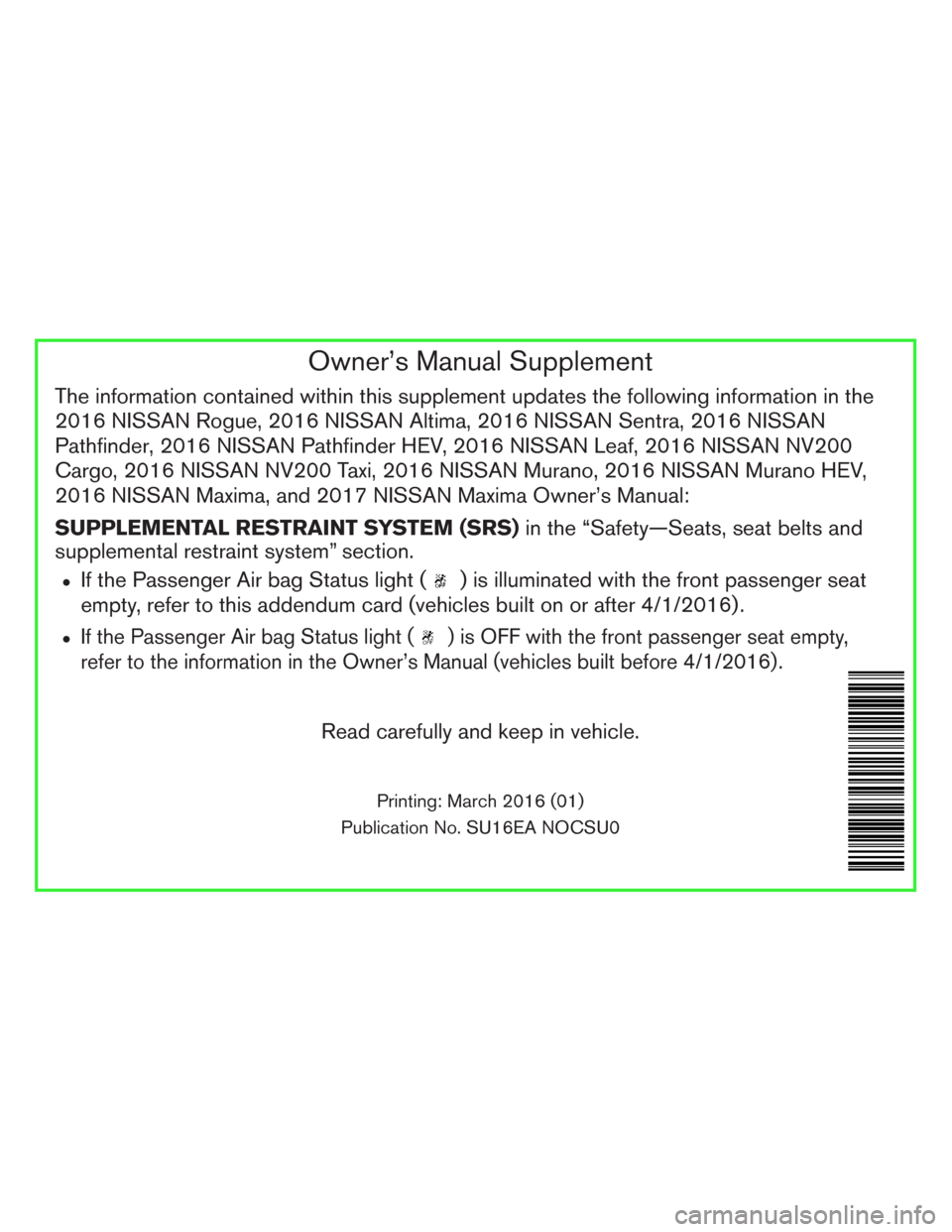
Owner’s Manual Supplement
The information contained within this supplement updates the following information in the
2016 NISSAN Rogue, 2016 NISSAN Altima, 2016 NISSAN Sentra, 2016 NISSAN
Pathfinder, 2016 NISSAN Pathfinder HEV, 2016 NISSAN Leaf, 2016 NISSAN NV200
Cargo, 2016 NISSAN NV200 Taxi, 2016 NISSAN Murano, 2016 NISSAN Murano HEV,
2016 NISSAN Maxima, and 2017 NISSAN Maxima Owner’s Manual:
SUPPLEMENTAL RESTRAINT SYSTEM (SRS)in the “Safety—Seats, seat belts and
supplemental restraint system” section.
●If the Passenger Air bag Status light () is illuminated with the front passenger seat
empty, refer to this addendum card (vehicles built on or after 4/1/2016) .
●If the Passenger Air bag Status light () is OFF with the front passenger seat empty,
refer to the information in the Owner’s Manual (vehicles built before 4/1/2016) .
Read carefully and keep in vehicle.
Printing: March 2016 (01)
Publication No. SU16EA NOCSU0